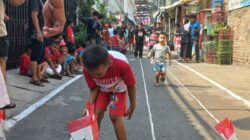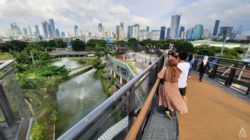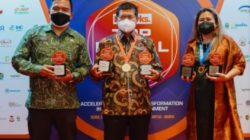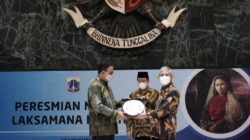By: Anies Rasyid Baswedan (Governor of DKI Jakarta)
This year’s Independence Day looks different for the children in Kampung Aquarium. Their smiles now they watched the Aquarium Stacking Village which finally stood after a long struggle.
Five years ago, after school, hopes of a bright future soon vanished. The house of one village was razed bulldozers. An irony, residents become refugees in their own villages: Houses are swept away, residency status is revoked. The future feels dark.
Those years have been a tough experience for children on the north coast of the capital. However, on August 17, 2021, although the bad memories cannot be erased, the future can come back to life. Kampung Susun Aquarium managed to stand up.
In the village, all residents are devastated about the desired plan according to the pattern of social interaction of their daily daily and economic activities. People are not taken from their roots, but feel they have what is rightfully theirs.
In fact, the pattern of ownership is not transactional. Residents are not placed simply as tenants, but residents form residential cooperatives. Its members are only residents.
The government entrusts this cooperative to manage and care for bunk villages. Yes, they are still simple economic circumstances, but do not underestimate the ability of citizens. They can work together and manage their villages collectively.
Collective collaboration in Kampung Susun Aquarium is proof that building a city village is not just building, but presenting a living space that humanizes its citizens.
The story of Kampung Susun Aquarium is just one of 21 villages organized with a more humanist approach. We call it the Community Action Plan (CAP). The key word: Community!
Humanizing citizens
A top down development approach that only makes citizens as objects is no longer relevant. It’s an era of collaboration and citizens are subjects that play an active role in development, not being objects left behind by the roar of progress.
Community Action Plan is a joint effort to realize a collaborative approach and humanize citizens in the development of urban villages.
Other villages such as Kampung Tanah Merah which was previously isolated now get access through infrastructure development such as bridges, public transportation, and clean water supply.
Even houses that have stood for decades but do not have an IMB (Building Permit) because the legal status of the land has not been completed is now given a solution that is a collective IMB.One IMB for all buildings in one Neighboring Pillar (RT). Not IMB per house but per community. It was the first breakthrough in the Republic.
With the collective IMB, they can now receive electricity, water flow and other basic services. The status of unfinished land does not need to make residents lose their basic rights such as water and electricity.
Such a solution comes after lengthy discussions with citizens and all stakeholders. As a trust, we strive to continue to accommodate and provide space for aspiration to jointly find solutions. Bureaucratic approaches that tend to be authoritative and close alternative solutions in solving various problems of citizens we no longer use.
The Latest: The Development of Productive Stacking Village Grows Cakung for the residents of Bukit Duri. The community approach with local residents and accompanying architects seeks to present a bunk village that moves from the needs and activities of residents.
It is wrong to look at city villages such as Kampung Aquarium, Tanah Merah, Bukit Duri, and many other urban villages just as a collection of houses. The city villages are the most visible mirror of unity. The village is one, it contains one thousand and one human elements. That’s our village.
The construction of the city village should not be interpreted solely as the construction of a row of dead buildings, but is seen as a unity of living social buildings. That’s the village. That’s the cultural basis of our nation’s togetherness. The villages of the city are trying to let us come, instead of being judged. Eliminate the problem not negate the village.
The approach is different for each region, not using one solution for all. Each region has different characters and life problems. That uniqueness should be empowered, not even removed and standardized.
Instead of feeling most knowing and authoritative, the DKI Provincial Government seeks to present a space of collaboration between communities. Citizens, facilitators, experts, and governments work together (co-creation) to find a common solution for each city village.
Equitable Progress
Still heard by the words of Sandyawan Sumardi, a community activist in Bukit Duri, when the Provincial Government of DKI together with the community of residents will build a Productive Stacking Village Growing Cakung. He said, “Having our own residential home is the beginning of our struggle life story.”
For people, the house is not just a physical building. Home is a living space, a hope for a better future in the capital.
Unfortunately, when it comes to progress, there is a normalizing perception that there are citizens who are victims of progress. This perception implicitly says that removal is considered normal as long as the victim is someone else, not yourself. We’re changing that paradigm that doesn’t humanize like that.
Progress must humanize. Provide equality and equal opportunity for all its citizens. Without it all, solidarity and unity of citizens would be impossible to realize.
Jakarta is a city of hope, a space that accommodates a variety of dreams and hopes from all corners of the Republic. Mention tribes and religions from all over the country, all in Jakarta.
Jakarta as a home for all, this is an idea that we continue to realize with work and policies. A warm home for all its people. A home that presents interactions that unite and protect, instead of separating and alienating.
A unifying home, because of the presence of equality and social justice for all its citizens!
* This post has been posted on Anies Baswedan’s Facebook










